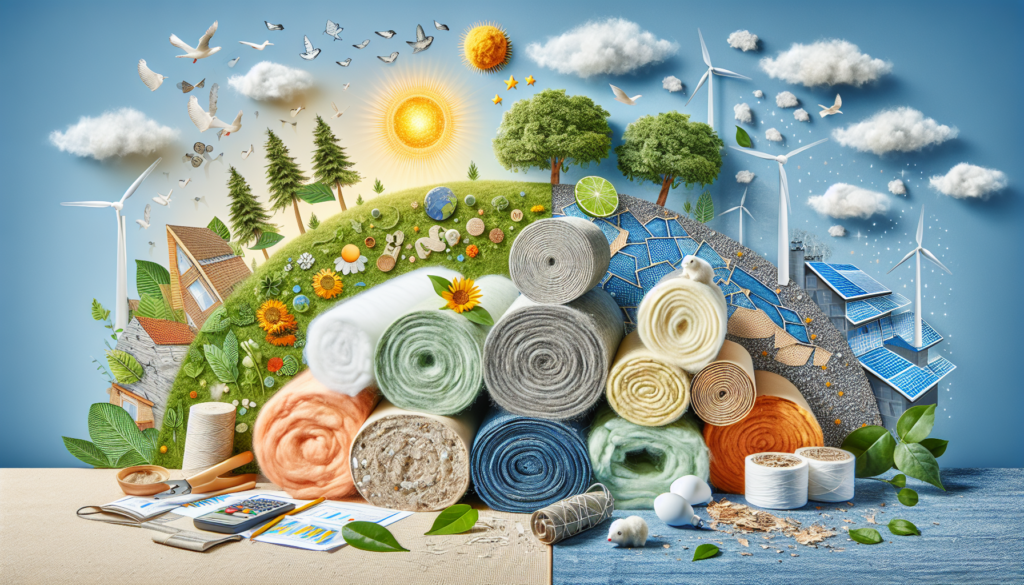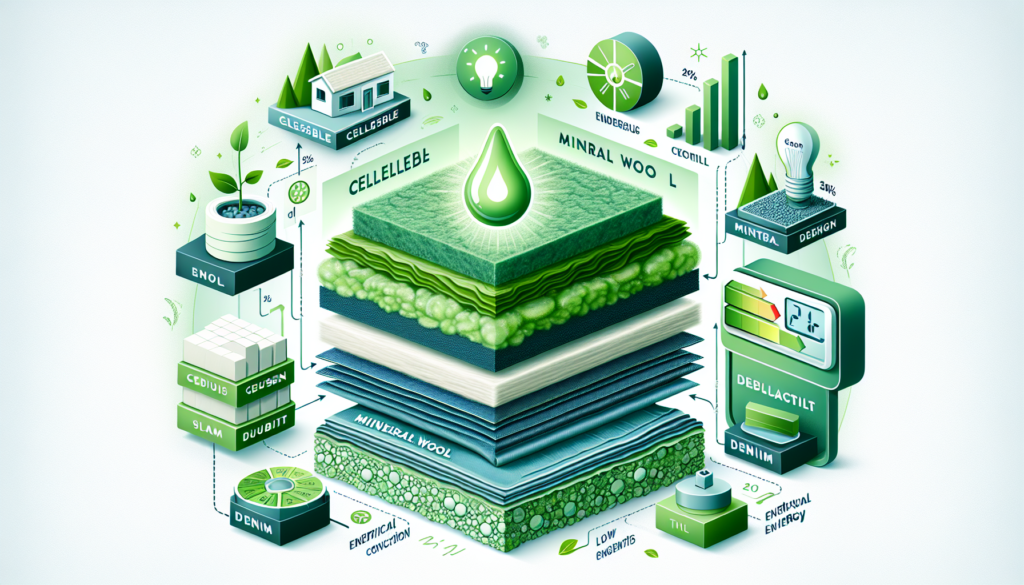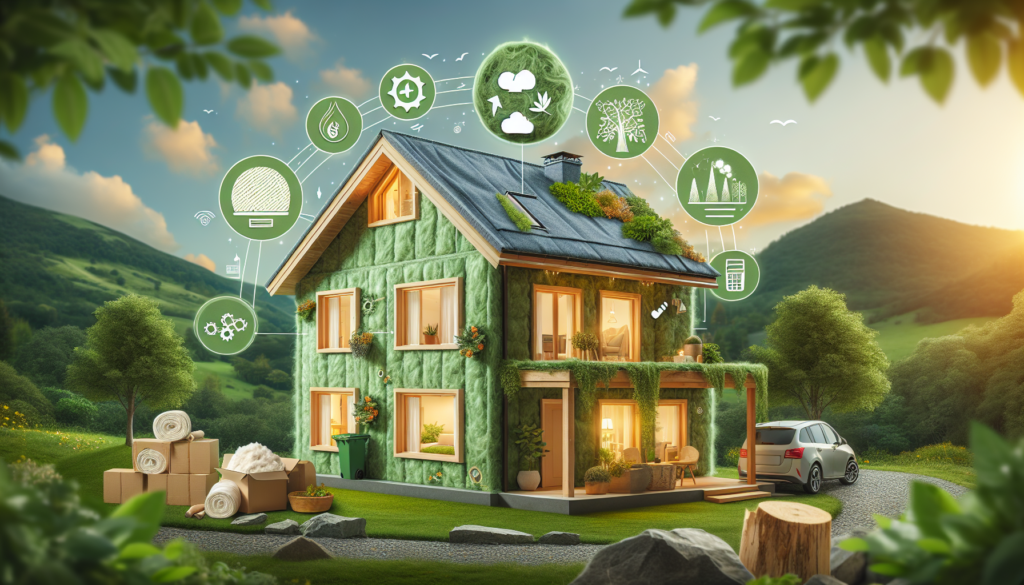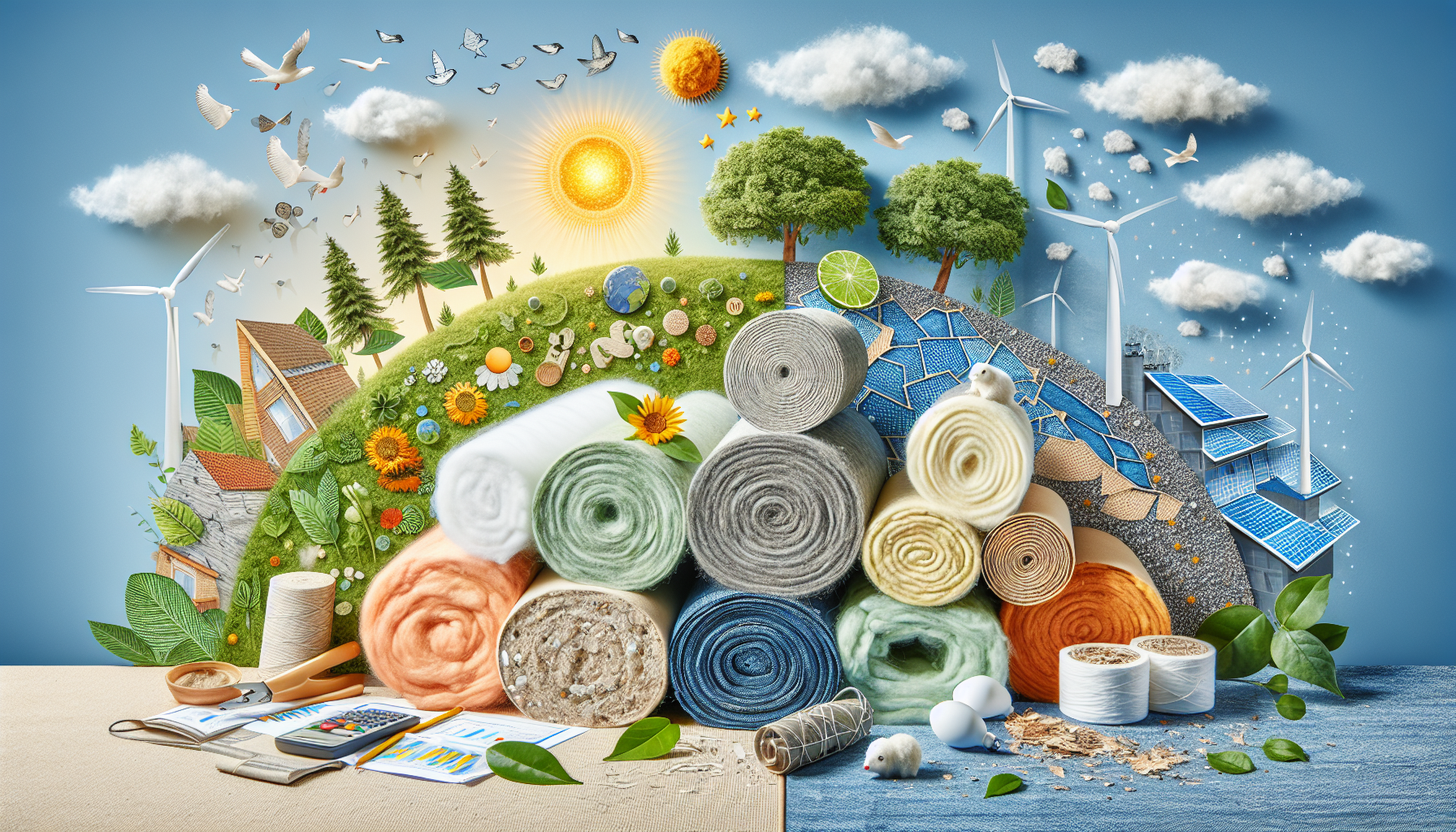In this article, you will discover a comprehensive comparison of various types of eco-friendly insulation. As climate change continues to be a pressing issue, finding sustainable solutions for our homes has become more important than ever. From recycled materials to natural fibers, there are numerous insulation options available that not only improve energy efficiency but also minimize environmental impact. Whether you’re building a new house or considering an upgrade, this article will help you make an informed decision about the best eco-friendly insulation for your needs.
Types of Eco-Friendly Insulation
When it comes to insulating your home or building, choosing an eco-friendly option is not only beneficial for the environment but also for your energy bill. There are various types of eco-friendly insulation materials available in the market, each with its own set of advantages and disadvantages. In this article, we will explore the different types of eco-friendly insulation and delve into their features, costs, and installation processes. So, let’s get started!
1. Cellulose Insulation
What is Cellulose Insulation?
Cellulose insulation is made from recycled paper products, usually from newsprint, which are treated with chemicals to resist fire, mold, and pests. It is a popular choice for eco-conscious homeowners due to its affordability and high R-value (thermal resistance).
Advantages of Cellulose Insulation
One of the major advantages of cellulose insulation is its excellent ability to reduce heat transfer and retain warmth in winter and coolness in summer. Additionally, it is a great sound barrier, absorbing and dampening noise effectively. Cellulose insulation is also resistant to fire and insects, providing added safety and protection.
Disadvantages of Cellulose Insulation
A potential drawback of cellulose insulation is that it can settle over time, reducing its effectiveness. It may also require additional fire-retardant treatments to meet building codes. Furthermore, installation can be a messy process due to the loose fibers.
Cost of Cellulose Insulation
Cellulose insulation is a cost-effective option, typically priced at around $0.50 to $1.50 per square foot, depending on the thickness and quality of the material.
Installation Process of Cellulose Insulation
To install cellulose insulation, it is usually blown into wall cavities or attics using specialized equipment. The loose fibers are evenly distributed, creating a seamless thermal barrier. It is recommended to hire a professional insulation contractor to ensure proper installation.

2. Fiberglass Insulation
What is Fiberglass Insulation?
Fiberglass insulation is made from spun glass fibers that are lightweight and flexible. It remains one of the most popular insulation materials due to its affordability and effectiveness in reducing heat transfer.
Advantages of Fiberglass Insulation
Fiberglass insulation offers excellent thermal performance, improving energy efficiency and reducing heating and cooling costs. It is also resistant to fire and moisture, preventing the growth of mold and mildew. Additionally, fiberglass insulation is easy to install and can be purchased in pre-cut batts or rolls.
Disadvantages of Fiberglass Insulation
One disadvantage of fiberglass insulation is that it may cause skin irritation due to the presence of tiny glass fibers. Therefore, it is important to wear protective clothing and a mask during installation. Moreover, fiberglass insulation has a lower R-value compared to some other insulation materials, necessitating thicker layers for optimal thermal resistance.
Cost of Fiberglass Insulation
Fiberglass insulation is widely available and relatively inexpensive. The cost typically ranges from $0.25 to $0.70 per square foot, depending on the thickness and quality of the insulation.
Installation Process of Fiberglass Insulation
Fiberglass insulation can be easily installed by homeowners. It is commonly installed in attics, walls, and crawlspaces by placing batts or rolls between the studs, beams, or joists. Proper handling and safety precautions should be followed to minimize fibers becoming airborne.
3. Mineral Wool Insulation
What is Mineral Wool Insulation?
Mineral wool insulation, also known as rock wool or stone wool insulation, is made from melted basalt or slag, which is then spun into fibers. It is a versatile and eco-friendly insulation material that offers excellent thermal and acoustic properties.
Advantages of Mineral Wool Insulation
Mineral wool insulation has excellent fire resistance, making it one of the top choices for fireproofing. It is also water repellent, preventing the growth of mold and mildew. Moreover, mineral wool has high sound absorption qualities, reducing noise transmission between rooms.
Disadvantages of Mineral Wool Insulation
One disadvantage of mineral wool insulation is its higher cost compared to other insulation materials. Additionally, its fibers can be irritating to the skin, so protective clothing and equipment should be worn during installation. Furthermore, mineral wool insulation is less effective in very humid conditions.
Cost of Mineral Wool Insulation
Mineral wool insulation is generally more expensive than other insulation materials, typically ranging from $0.80 to $1.50 per square foot. The higher cost is attributed to its superior fire resistance and acoustic properties.
Installation Process of Mineral Wool Insulation
Mineral wool insulation can be installed in a similar way to fiberglass insulation, using batts or rolls. It is important to wear protective gear and follow the manufacturer’s instructions for proper installation. Hiring a professional may be necessary for large or complex projects.

4. Cotton Insulation
What is Cotton Insulation?
Cotton insulation, also known as natural fiber insulation, is made from recycled denim or cotton fibers. It is a sustainable and environmentally friendly alternative to traditional insulation materials.
Advantages of Cotton Insulation
Cotton insulation offers excellent thermal performance, reducing heat transfer and improving energy efficiency. It is also a highly effective sound barrier, minimizing external noise. Moreover, cotton insulation is safe and easy to handle, as it does not contain any harsh chemicals or irritants.
Disadvantages of Cotton Insulation
One potential disadvantage of cotton insulation is its susceptibility to mold and mildew in humid environments. Therefore, it is important to address any moisture issues before installation. Additionally, cotton insulation, especially when made from recycled denim, can be more expensive compared to other insulation materials.
Cost of Cotton Insulation
Cotton insulation generally costs between $0.80 and $2.00 per square foot, depending on the thickness and quality of the material. While it may be pricier than some other options, the eco-friendly and health benefits make it a worthwhile investment for many homeowners.
Installation Process of Cotton Insulation
Cotton insulation can be installed using the same methods as fiberglass or mineral wool insulation. Batts or rolls are placed between the studs, beams, or joists, ensuring a tight fit to minimize air gaps. Protective gear should be worn during installation to avoid skin irritation.
5. Sheep’s Wool Insulation
What is Sheep’s Wool Insulation?
Sheep’s wool insulation, as the name suggests, is made from the wool of sheep. It is a natural and sustainable insulation material that offers a range of benefits.
Advantages of Sheep’s Wool Insulation
Sheep’s wool insulation has excellent thermal properties and is highly effective in reducing heat loss and gain. It is also breathable, allowing moisture to evaporate and preventing condensation build-up. Additionally, sheep’s wool is naturally fire-resistant and can absorb and release moisture without compromising its insulation capabilities.
Disadvantages of Sheep’s Wool Insulation
One potential disadvantage of sheep’s wool insulation is its higher cost compared to mainstream insulation materials. The availability of sheep’s wool insulation may also be limited in certain regions. Furthermore, individuals with wool allergies may experience discomfort when handling the material.
Cost of Sheep’s Wool Insulation
Sheep’s wool insulation typically costs between $1.50 and $3.50 per square foot. While it may be more expensive upfront, the long-term energy savings make it a worthwhile investment for those seeking sustainable and efficient insulation.
Installation Process of Sheep’s Wool Insulation
Sheep’s wool insulation can be easily installed using the same methods as other insulation materials. Batts or rolls are placed between the studs, beams, or joists, ensuring a snug fit. It is important to follow the manufacturer’s instructions for proper installation and wear appropriate protective gear.

6. Hemp Insulation
What is Hemp Insulation?
Hemp insulation is made from the fibers of the hemp plant, a highly renewable and sustainable resource. It is an eco-friendly alternative to traditional insulation materials that offers several benefits.
Advantages of Hemp Insulation
Hemp insulation provides excellent thermal performance, reducing heat transfer and energy loss. It is also breathable and resistant to mold, mildew, and pests. Moreover, hemp insulation has excellent sound absorption properties, creating a peaceful and quiet living environment.
Disadvantages of Hemp Insulation
One drawback of hemp insulation is its higher cost compared to some other insulation materials. Additionally, its availability may be limited depending on the region. Hemp insulation may also require additional fire-resistant treatment to meet local building codes.
Cost of Hemp Insulation
Hemp insulation typically costs between $2.50 and $4.00 per square foot. While it may have a higher upfront cost, the long-term energy savings and environmental benefits make it a popular choice for those seeking sustainable insulation options.
Installation Process of Hemp Insulation
Hemp insulation can be installed using the same methods as other insulation materials, such as batts or rolls. Protective gear should be worn during installation, and it is recommended to seek professional assistance for large or complex projects.
7. Recycled Denim Insulation
What is Recycled Denim Insulation?
Recycled denim insulation is made from discarded denim jeans and other cotton materials. It is an eco-friendly and sustainable insulation option that offers numerous benefits.
Advantages of Recycled Denim Insulation
Recycled denim insulation provides excellent thermal performance, reducing heat transfer and improving energy efficiency. It is also a safe and non-toxic option, making it suitable for individuals with allergies or sensitivities. Moreover, recycled denim insulation has excellent sound absorption qualities, minimizing noise pollution.
Disadvantages of Recycled Denim Insulation
One potential disadvantage of recycled denim insulation is its higher cost compared to mainstream insulation materials. It may also require additional fire-retardant treatment to meet building codes. Additionally, the installation process can be more challenging, requiring professionals with specialized equipment.
Cost of Recycled Denim Insulation
Recycled denim insulation generally costs between $2.00 and $4.00 per square foot. While it may have a higher upfront cost, the long-term energy savings and eco-friendly nature of the product make it an attractive option for many homeowners.
Installation Process of Recycled Denim Insulation
Recycled denim insulation is most commonly installed using the blown-in technique. Specialized equipment is used to blow loose fibers into wall cavities or attics, ensuring complete coverage. It is recommended to hire a professional insulation contractor to ensure proper installation and minimize any potential health or safety risks.

8. Polystyrene Insulation
What is Polystyrene Insulation?
Polystyrene insulation is a popular insulation material that is made from expanded or extruded polystyrene foam. It is available in two main forms: expanded polystyrene (EPS) and extruded polystyrene (XPS).
Advantages of Polystyrene Insulation
Polystyrene insulation offers excellent thermal resistance, helping to reduce energy consumption and lower heating and cooling costs. It also has a high compressive strength, making it suitable for various applications. Moreover, polystyrene insulation is resistant to moisture, mold, and pests, ensuring long-term durability.
Disadvantages of Polystyrene Insulation
One potential drawback of polystyrene insulation is its environmental impact. Polystyrene is derived from petroleum, a non-renewable resource, and the manufacturing process produces greenhouse gases. Additionally, polystyrene insulation can release toxic fumes if exposed to fire.
Cost of Polystyrene Insulation
Polystyrene insulation is generally affordable, with costs ranging from $0.70 to $1.50 per square foot, depending on the type of polystyrene and the thickness of the insulation.
Installation Process of Polystyrene Insulation
Polystyrene insulation can be easily installed using the same methods as other insulation materials, such as cutting and fitting the foam boards into the desired areas. It is important to adhere to local building codes and safety guidelines when installing polystyrene insulation.
10. Aerogel Insulation
What is Aerogel Insulation?
Aerogel insulation is a highly efficient and advanced insulation material that is composed of silica aerogel, a gel-based material with extremely low density and high thermal resistance.
Advantages of Aerogel Insulation
Aerogel insulation offers the highest thermal resistance value per inch compared to other insulation materials, making it incredibly effective in reducing heat transfer. It is also lightweight and flexible, allowing for easy installation in various spaces. Moreover, aerogel insulation is hydrophobic, repelling water and resisting mold and mildew growth.
Disadvantages of Aerogel Insulation
One major drawback of aerogel insulation is its high cost. Aerogel is an advanced material that requires specialized manufacturing processes, making it pricier compared to other insulation options. Additionally, aerogel insulation can be fragile and brittle, requiring careful handling during installation.
Cost of Aerogel Insulation
Aerogel insulation is one of the most expensive insulation options, with costs ranging from $6.00 to $10.00 per square foot. Its high cost is attributed to the advanced technology and materials used in its production.
Installation Process of Aerogel Insulation
Due to its fragile nature, aerogel insulation should be handled with care during installation. It is commonly available in panel or blanket forms and can be cut to fit the desired spaces. It is recommended to hire professionals experienced in working with aerogel insulation to ensure proper installation and maximize its effectiveness.
In conclusion, there are various types of eco-friendly insulation materials available, each with its own unique features, advantages, and disadvantages. Whether you choose cellulose, fiberglass, mineral wool, cotton, sheep’s wool, hemp, recycled denim, polystyrene, or aerogel insulation, each option provides a sustainable and efficient solution for insulating your home or building. It is important to consider factors such as cost, installation process, and specific requirements of your project before making a decision. By selecting the right eco-friendly insulation material, you can not only reduce energy consumption and save money but also contribute to a greener and more sustainable future.

